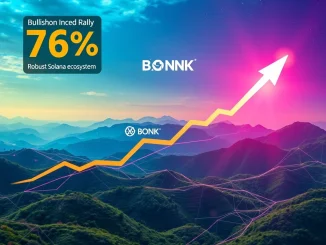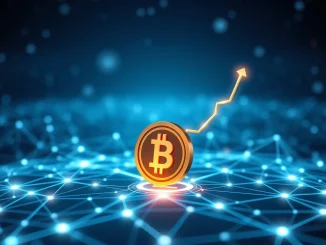
The world of decentralized finance (DeFi) is constantly evolving, and a groundbreaking development on the Solana blockchain is turning heads. In a remarkable display of market confidence and innovation, Solana tokenized stocks have achieved an astounding 242% surge in market capitalization within just one month. This meteoric rise signals a pivotal moment for blockchain finance, bridging the gap between traditional equity markets and the burgeoning crypto ecosystem. For anyone interested in the bleeding edge of crypto and investment, this trend is impossible to ignore.
The Phenomenal Rise of Solana Tokenized Stocks
Just launched on June 30, Solana tokenized stocks, primarily driven by xStocks issued by Backed Finance, have already surpassed the $100 million mark. As of July 22, the market cap for these innovative assets reached an impressive $102 million, rocketing from an initial valuation of $29.8 million. This rapid adoption has not only validated the concept but also positioned Solana as a formidable player in the tokenized asset sector.
Consider the market landscape:
- Solana’s Dominance: Solana now commands a significant 20.4% share of the tokenized stock market.
- Outpacing Competitors: This figure dramatically outstrips Ethereum and its layer-2 counterparts (Arbitrum, Polygon, and Base), which collectively hold a mere $11.8 million.
Leading the charge are familiar names from traditional finance, reimagined for the blockchain. TSLAx, representing Tesla shares, leads with a $13.6 million market cap and over 11,000 holders. It’s followed by tokenized S&P 500 derivatives like SPYx ($10.1 million) and CRCLx (Circle’s tokenized shares at $9.1 million). The on-chain trading volume for xStocks has also soared, surpassing $300 million, underscoring robust investor interest.
Decoding the Power of xStocks by Backed Finance
What exactly are xStocks, and why are they gaining such traction? xStocks are a type of tokenized assets that represent traditional financial securities, such as shares of publicly traded companies or ETFs, on a blockchain. Issued by Backed Finance, these tokens allow investors to gain exposure to traditional markets directly from the crypto ecosystem, offering benefits like:
- Fractional Ownership: Buy a fraction of a Tesla share, making high-value stocks accessible to more investors.
- 24/7 Trading: Unlike traditional markets, blockchain-based assets can be traded around the clock.
- Increased Liquidity: Potentially higher liquidity compared to traditional, less accessible markets.
- Global Access: Lower barriers to entry for international investors.
The choice of Solana as the underlying blockchain for these assets is strategic. Solana’s high throughput, low transaction costs, and rapid finality make it an ideal platform for high-frequency trading and the issuance of a large volume of tokenized securities, providing a smooth user experience that traditional finance users might appreciate.
The Paradox: Why Does DeFi Integration Lag for Tokenized Assets?
Despite the explosive growth in market capitalization and trading volume, a curious paradox exists: the DeFi integration of these tokenized assets remains notably underdeveloped. While platforms like Kamino and Raydium support xStocks as collateral or liquidity pools, their utilization rates are strikingly low.
Let’s look at the numbers:
| Platform/Asset | Total Market Value (xStocks) | Deposited as Collateral/In Liquidity Pool | Utilization Rate |
|---|---|---|---|
| Kamino (8 xStocks) | $50 million | $585,000 | 1.17% (11% of the total value of xStocks held by Kamino users, not overall market cap) |
| Raydium (TSLAx Pool) | $1.1 million (Pool total) | $423,600 (Tokenized stock portion) | 38.5% (of pool total) / 4.7% (overall DeFi participation for TSLAx) |
| Raydium (SPYx Pool) | $1.9 million (Pool total) | $502,000 (Tokenized stock portion) | 26.4% (of pool total) / 7% (overall DeFi participation for SPYx) |
This data reveals a significant gap. Michael Cahill, CEO and co-founder of Douro Labs, sheds light on this phenomenon, attributing it to a ‘unidirectional flow of capital from crypto to traditional finance.’ He notes that ‘Holders entering crypto from traditional markets aren’t yet leveraging DeFi composability.’
He cited the Apollo Diversified Credit Securitized Fund (ACRED) as a prime example, holding $100 million in net assets but deploying only a fraction in on-chain lending. This highlights a systemic underutilization of blockchain’s inherent composability – the ability to seamlessly combine different DeFi protocols to create new financial products and services.
Bridging the Gap: Enhancing DeFi Integration
The underutilization of Solana tokenized stocks in DeFi stems from several factors:
- User Familiarity: Traditional finance users, while drawn to tokenized stocks, may not be familiar with DeFi protocols, wallets, and the nuances of lending or liquidity provision.
- Interface Complexity: Current DeFi interfaces, while improving, can still be daunting for newcomers.
- Risk Perception: The perceived risks associated with smart contracts, impermanent loss, and volatile crypto markets deter some traditional investors.
- Nascent Market: Tokenized stocks are a relatively new asset class, and the ecosystem for their DeFi integration is still maturing. As Cahill pointed out, ‘We didn’t have this last year,’ contrasting it with earlier, less successful attempts like Terra’s Mirror project.
To truly unlock the potential of blockchain finance, particularly for tokenized assets, several steps are crucial. Cahill anticipates gradual growth as traditional finance users become more accustomed to blockchain tools. He emphasized that a ‘big company moment,’ similar to Strategy’s tokenized shares, could significantly accelerate adoption. However, the most impactful change will come from ‘improved product experiences bridging traditional and on-chain interfaces.’ Simplifying the user journey, enhancing security, and providing clearer educational resources will be key to encouraging greater DeFi participation.
The Future of Tokenized Assets on Solana
The rapid ascent of the Solana tokenized stocks market is a powerful testament to the growing interest in blockchain-based financial products. It signals a future where traditional assets are more accessible, liquid, and programmable. While the current DeFi integration lags, it represents an enormous untapped potential.
As investors from both traditional and decentralized finance spheres continue to converge, the path forward hinges on fostering a more seamless and intuitive experience. User education, robust infrastructure, and innovative product design will be paramount in bridging the existing gap between asset tokenization and the powerful composability of DeFi. The journey has just begun, and Solana is clearly at the forefront of this exciting financial revolution.
Frequently Asked Questions (FAQs)
What are Solana tokenized stocks?
Solana tokenized stocks are digital tokens issued on the Solana blockchain that represent ownership or exposure to traditional financial assets like company shares (e.g., Tesla, S&P 500 ETFs). They allow for fractional ownership, 24/7 trading, and global accessibility.
How much have Solana tokenized stocks grown recently?
Within one month of their launch (June 30 to July 22), Solana tokenized stocks surged by 242%, increasing their market capitalization from $29.8 million to $102 million.
Why is DeFi integration for tokenized stocks still low?
Despite their market cap growth, DeFi integration is low due to factors like traditional finance users’ unfamiliarity with DeFi, complex interfaces, perceived risks of smart contracts, and the nascent stage of the tokenized asset market. Capital tends to flow unidirectionally from crypto to traditional finance exposure rather than leveraging DeFi composability.
What are xStocks, and who issues them?
xStocks are a specific type of tokenized stock issued by Backed Finance. They are built on the Solana blockchain and represent shares of various traditional companies and indices, such as TSLAx (Tesla) and SPYx (S&P 500).
What is the future outlook for tokenized assets on Solana?
The future outlook is promising, with significant potential for growth. As user experiences improve, traditional finance users become more comfortable with blockchain tools, and more intuitive interfaces emerge, DeFi integration for tokenized assets on Solana is expected to increase, unlocking greater utility and liquidity.
How does Solana compare to Ethereum in the tokenized stock market?
Solana has quickly emerged as a dominant player in the tokenized stock market, capturing 20.4% of the market share. This significantly surpasses Ethereum and its layer-2 blockchains (Arbitrum, Polygon, Base), which collectively hold a smaller portion of the market, around $11.8 million, indicating Solana’s rapid ascent in this specific sector.



